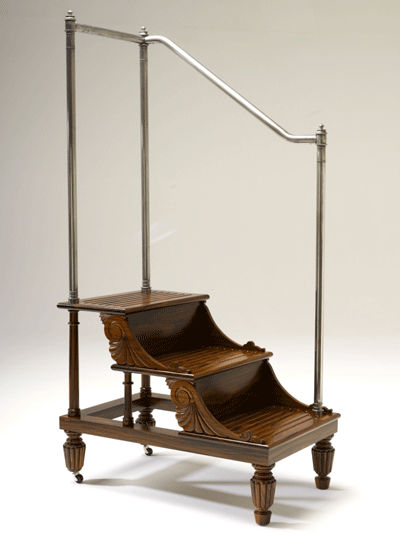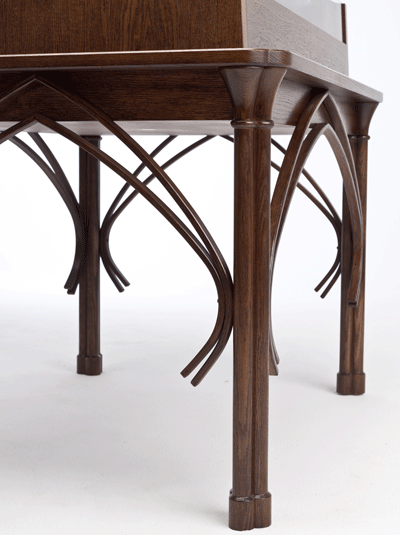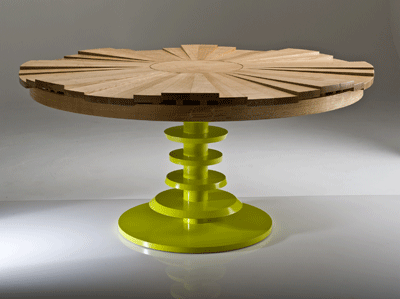Historic interiors, new furniture
You don't necessarily have to replicate historic furniture for historic interiors; after all past generations filled their houses with inherited furniture from different periods

As soon as contemporary or modern design is mentioned there are immediate concerns that it will be inappropriate to a historic building, but why? Perhaps this is often because what is classed as ‘modern' is merely poorly designed, but the best of modern design can hold its head up amongst the finest of historical pieces. The reason for this is clear, intelligent investment in the design, the materials and the craftsmanship.
Of course there are times when making a replica or a piece in a historic style is appropriate, but it should not automatically be the default position. Almost all historic buildings will have interior fitments that span tens if not hundreds of years; but because they are collectively seen as old there is little question of the appropriateness of a 17th century piece sitting alongside an 18th century piece. This is because there is usually a unifying quality and continuity of form. Put simply, the two styles do not jar the senses.

Good design should enhance its surroundings; a good designer is in tune with the heritage of the building and understands that the project is about the space, not self-promotion.
So what are the key factors to consider when furnishing such property?
1. Purpose Are you trying to make a statement or a practical addition to the building?
2. Style Are you trying to deliver a true replication of a historic style, a modern interpretation or a completely contemporary design?
3. Material Whilst we tend to think of furniture as being mostly timber the options for a new piece are quite extensive and historically stone and metal would have been used along with glass and embellishments of precious metals, semi-precious stone, marquetry, carving, gilding etc.
Exquisite houses, the beauty of Nature, and how to get the most from your life, straight to your inbox.
4. Designer The success of your project will be determined by the quality of the designer, so decide on the characteristics you need. Some designers will have little experience of historic styles, others will be hampered by an inability to accept that anything designed after 1870 is of any note, and some will have a set style, which they use with little variation. So it's important to spend as much time as possible deciding on who is right for your project.
5. Cabinetmaker Having resolved the design you will now need it made. Some designers have their own workshop, which is the simplest option, particular in respect of continuity and cost; otherwise you will need to select a suitable craftsperson. There are many possibilities and again it would be wise to consider the particular skill sets of the cabinetmaker, particularly if you are considering using a variety of materials.
6. Budget Be realistic at the outset about the costs of producing a suitable piece, it is unlikely that you will achieve very much of value for less than £5000.
There are a great many opinions about what to do with historic buildings and I am convinced that the answer is often different for each building. In the tragic fire at Windsor castle the State Dining Room sideboard was completely destroyed. It was the major piece of a suite of furniture and it was decided to make an exact replica of the sideboard. In other areas the opportunity was taken to design new elements to acknowledge that the building was a dynamic environment that had constantly changed over time.

At Eltham Palace the Art Deco extension was in good condition but much of its specifically designed furniture, had been lost over time, therefore it was appropriate to replicate them. Eltham Palace is, now rightly regarded as an architectural treasure, but one wonders if the current guardians, English Heritage, would have allowed the original extension had they been in charge at the time?
* Give Country Life for Christmas and save up to 40%
At the Palace of Westminster after decades of mock Pugin additions, the design philosophy is now to add contemporary pieces that are in keeping with the style of the building. Here too, a ‘modern' building was attached to an existing medieval building without too much complaint. Perhaps, an indication of a time when society was looking excitedly forward to greater things, rather than looking to past glories.
The benefit that independent private owners of historic buildings have is that they are largely free to look forward and many do, allowing designers to create wonderful new pieces that reflect the original design ethos of the building. They fully appreciate the quality of the old and the need to conserve, but equally they aspire to contribute to an evolving future.

Whatever path you take; make sure that history is given every chance to judge your contribution kindly.
Neil Stevenson is a successful designer and cabinetmaker who has worked on many of our finest historic buildings. There are a number of case studies that you can download at http://www.nejstevenson.co.uk/casestudies.htm including Eltham Palace and Dover Castle.

This is an article from ProjectBook which provides a wide range of information for the conservation, restoration, care and repair of period and listed buildings. NEJ Stevenson is a member of the Heritage Register which contains over 500 vetted craftsmen, contractors and consultants from all over the UK. Updated daily with new content, the website features the heritage register, a products directory, informative articles, current news, events and more. For more information, visit www.projectbook.co.uk.
Country Life is unlike any other magazine: the only glossy weekly on the newsstand and the only magazine that has been guest-edited by His Majesty The King not once, but twice. It is a celebration of modern rural life and all its diverse joys and pleasures — that was first published in Queen Victoria's Diamond Jubilee year. Our eclectic mixture of witty and informative content — from the most up-to-date property news and commentary and a coveted glimpse inside some of the UK's best houses and gardens, to gardening, the arts and interior design, written by experts in their field — still cannot be found in print or online, anywhere else.

